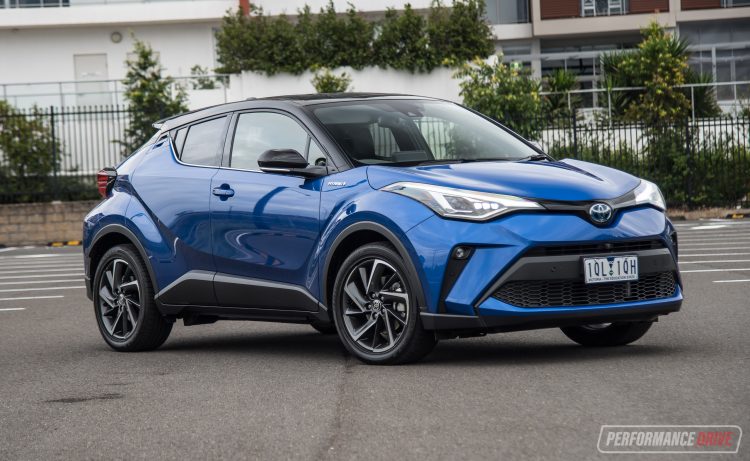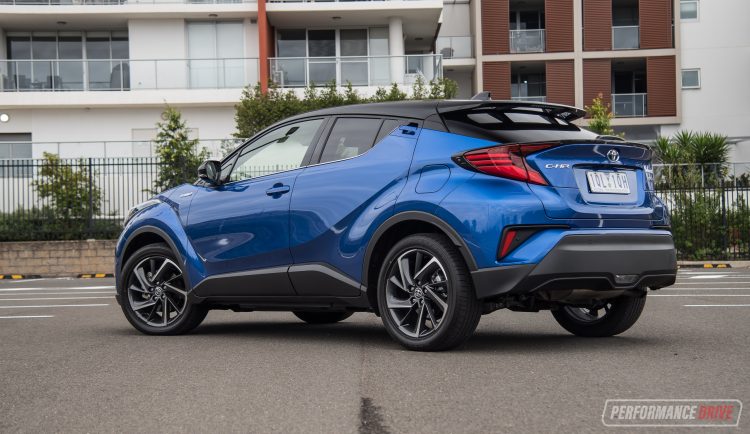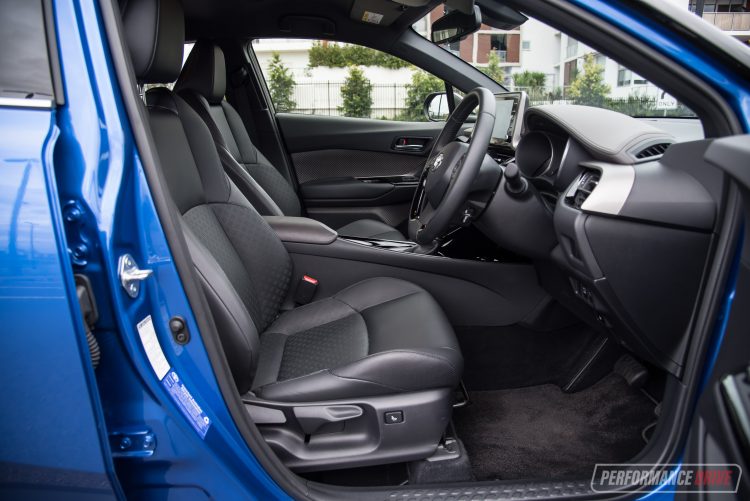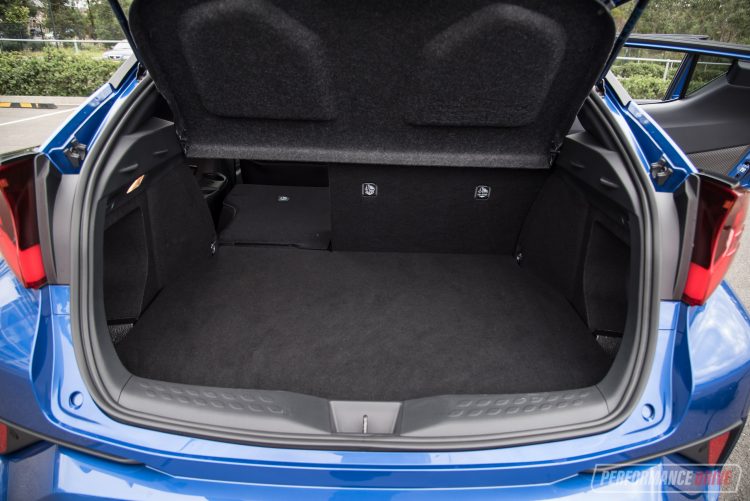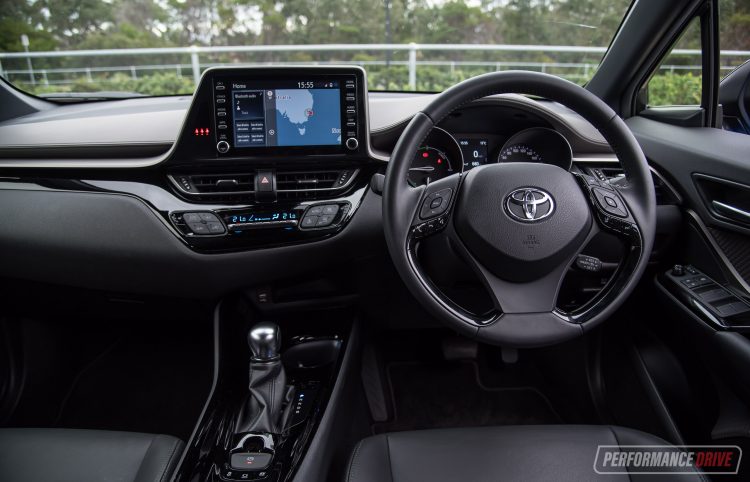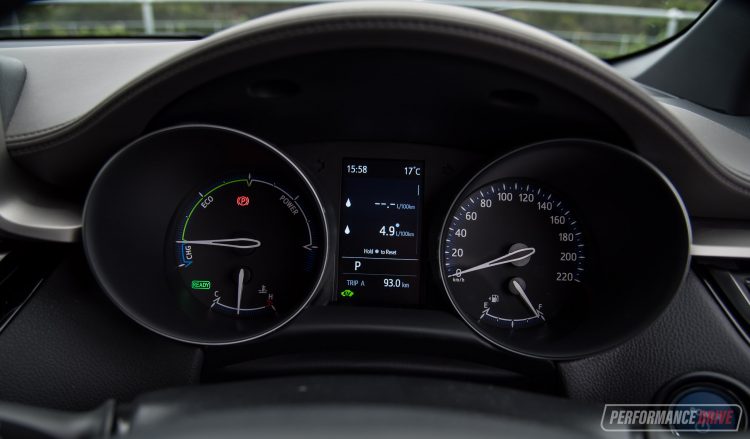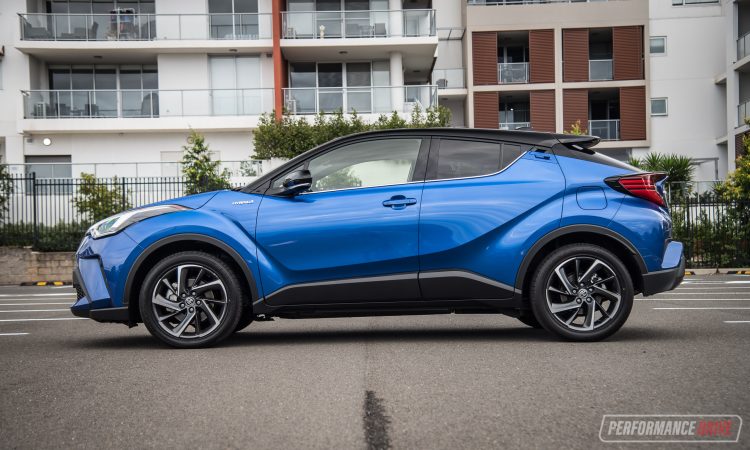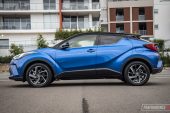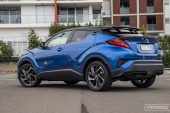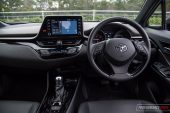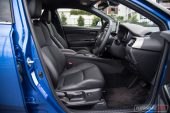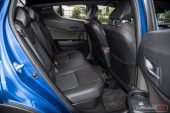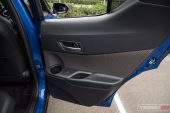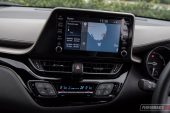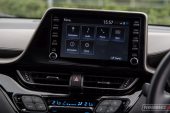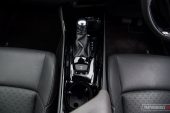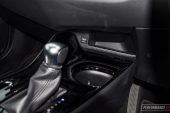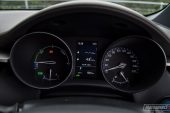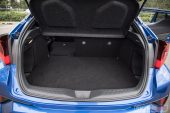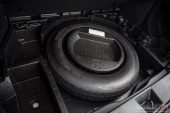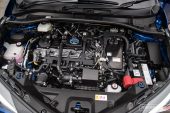The small SUV market continues to be spearheaded by the Toyota C-HR. Since its release in 2016, it has enjoyed strong sales from buyers who want a vehicle with the height of an SUV, the dynamics of a car, and the radical design of a sports car.
Buyers can choose from two powertrains and two variants of the 2020 Toyota C-HR. There’s a 1.2-litre turbo-petrol engine which produces 85kW and 185Nm (available in 2WD and AWD), and a new-for-2020 1.8-litre petrol hybrid that powers the front wheels only. It develops 90kW from the combined sources of power.
The Koba is the apex model, and the plainly named C-HR is the base model. No manual transmission is offered for the 2020 lineup in Australia. Here, we’re testing out the new hybrid which is only available in top Koba trim. Prices start from $30,290 for the base and rise to $37,190 (plus on-road costs) for this Koba hybrid. Plus $950 if you want the Nebula blue paint and black contrast roof, as featured here.
2020 Toyota C-HR Koba Hybrid – THE SPECS
[column width=”47%” padding=”6%”]Engine: 1.8-litre four-cylinder hybrid
Output (combined): 90kW
Transmission: CVT auto
Drive type: Front-wheel drive
Wheels: F & R: 18×7.0, 225/50
ANCAP: Five stars
Tare weight: 1435kg
Power-to-weight: 15.94:1 (kg:kW)
Official fuel economy: 4.3L/100km
Economy during test: 5.0L/100km
Fuel capacity/Type: 43L/91 RON[/column] [column width=”47%” padding=”0″]Power efficiency: 20.93kW:L/100km
0-60km/h: 5.78 seconds*
0-100km/h: 13.48 seconds*
60-110km/h: 10.76 seconds*
1/4 mile: 19.31 seconds at 118.9km/h*
Max acceleration: 0.602g
100-0km/h braking: 3.10 seconds at 40.35 metres*
Max deceleration: -1.267g
Decibel at idle (on standby): 25*
Peak decibel at 60-100km/h: 77*
Priced from: $37,190[/column][end_columns]
* Figures as tested by PerformanceDrive on the day. Factory claims may be different
2020 Toyota C-HR Koba Hybrid – THE PACKAGE
With a busy small SUV market, it’s refreshing to see one example with unconventional and edgy looks. The C-HR runs with huge swooping headlights, large flared wheel arches and rear pillars, and a coupe-like roofline and integrated rear spoiler. Its overall shape is a bit like the Hyundai Veloster, and its direct competitor, the Hyundai Kona. Love it or hate it, we think it’s youthful and funky, and distinctively Japanese.
The interior is not quite as out there in design as the exterior, but it is practical and easy to navigate. There is a commendable amount of room in the front row, and decent head clearance on entry/exit. In the rear, legroom is aplenty for a small SUV, but we dislike the small windows in the rear that block your view to the outside world. This is also an inhibition on the driver’s blind spot view. We find the seats comfortable and supportive, but power adjustment is missing in the front, despite being the flagship model.
Materials used throughout the interior feel high in quality. The only improvements that could be made are the 8.0-inch centre touch-screen and info screen in the dash could be higher in resolution; they are starting to look all too common and dated. The steering wheel buttons are also slanted in such a way that it is easy to bump the wrong button when driving.
If boot space is important to you, or you plan on using your C-HR for large, loaded camping trips, the boot offers only 318 litres of volume. The high boot floor makes it slightly smaller than a Toyota Corolla hatch’s 333L, and smaller than the Hyundai Kona’s 361L (332L in the all-electric Kona). It won’t quite fit a camping trip’s worth of supplies, or a ski trip’s heavy load, but you’ll easily manage your weekly shopping run. If you want more space in this class, the Kia Seltos (433L) and Renault Kadjar (408L) offer more.
All C-HR models inherit a generous list of safety tech and features as standard. You get a pre-collision safety system (with day and night pedestrian detection), all-speed active cruise control, lane departure alert with steering assist, auto high beam, blind-spot monitoring with rear cross-traffic alert, front and rear parking sensors, 17-inch alloy wheels, dual-zone climate control, and that 8.0-inch touch-screen with Bluetooth connectivity, Apple CarPlay, Android Auto, and sat-nav with SUNA live traffic.
Opting for the Koba will grant you additional features like 18-inch alloys, leather-accented upholstery with heated front seats and power adjustable lumbar support for the driver, a panoramic-view parking camera, and a proximity sensor for keyless locking/unlocking. Disappointingly, there is no option for a wireless phone charging pad, road sign recognition, rear air vents, or rear collision mitigation.
The C-HR comes standard with a five year/unlimited kilometre warranty, and a brilliant annual capped services schedule that costs only $195 each.
2020 Toyota C-HR Koba Hybrid – THE DRIVE
Toyota claims that as of November 2019, at least 90 percent of all electrified vehicles on Australian roads had a Toyota badge. So, there is a hard market fight against the strength that the Japanese brand brags. It also shows how established, tested and usable Toyota hybrid vehicles have become. For the C-HR, it’s an extremely easy hybrid to drive. You don’t need any extra knowledge or training to drive one over a conventionally powered car.
If you care about power, the C-HR hybrid might fall short of your demands. If power is of low importance to you, it still might fall short of your needs. But if you absolutely do not worry about having oomph, then the C-HR is a brilliant option. A combined power output of 90kW and 163Nm of torque from the engine (combined torque not specified), this offers less than your standard petrol Corolla (125kW).
As a result, we timed a best 0-100km/h run in 13.48 seconds. It doesn’t have the enthusiasm you occasionally need to keep up with the flow of the daily work commute, nor does it manage an overtaking situation on an incline on the freeway very well. And among all the hard work that is going on, the engine can sound harsh and droned. We’d love to see power improvements to match the hip design of the rest of the vehicle.
Okay, you could say the C-HR shouldn’t be judged all on its engine performance. So, let’s focus on what it does well; fuel economy. The official average usage is 4.3L/100km. We recorded 5.0L/100km during our week of driving, which is quite impressive. But you’re compromising on performance significantly to achieve this.
And we notice that it really depends on the type of driving you do. For example, if your common commute has you travelling at freeway speeds, the consumption for this increases. This is because the petrol side is used more above 80km/h. If you’re mostly nipping around town, under 60km/h, you will benefit from the electric motor most.
If you’re interested in maximising that electric advantage, you can whack it in EV mode, which will see it run entirely without the petrol engine for a short time (depending on how much braking or hills you encounter), or unless you pump the accelerator more than half way down.
In terms of driving dynamics, the C-HR is surprisingly sturdy and agile – contrary to the performance of the engine. It’s based on the company’s latest TNGA platform, and includes MacPherson struts up front, and the rear goes with an independent trailing wishbone setup with coil springs and a stabiliser bar. You can approach corners with nominal body roll and it returns praiseworthy stability.
Going over bumps and country roads is a pleasant experience in the C-HR. It’s perfectly balanced between sportiness and soft enough to provide smooth and refined comfort. Also, the steering has a nice weight to it, with few turns of the wheel needed to give off that sporty sensation. Overall, it’s a great-handling package and one that can be a lot of fun on the right road. Downhill, preferably.
2020 Toyota C-HR Koba Hybrid – THE VIDEO
2020 Toyota C-HR Koba Hybrid – THE VERDICT
Hybrid technology is now a common solution to combat fuel consumption in the automotive world, especially in Toyotas. In the C-HR, it’s great to jump into a hybrid without it feeling any different to a conventional SUV. You do sacrifice power and performance here, though, to the benefit of excellent fuel consumption figures.
There are other, more affordable alternatives in this category of the market, but the feature listing in the standard model is impressive. It also feels nice to drive and offers a smooth and relaxing ride. And lastly, you have Toyota’s reputable peace of mind and resale value.
[column width=”47%” padding=”6%”]PROS:
– Excellent real-world fuel consumption
– Handling and dynamics are admirable
– Striking and youthful design that looks different to the rest
– Easy to drive and fuss-free[/column] [column width=”47%” padding=”0″]CONS:
– Poor rear visibility, claustrophobic rear seat
– Low resolution touch-screen
– Slow getting up to highway speeds[/column][end_columns]
As always, if you’re thinking about buying a new car don’t forget to click here to speak with our car buying specialists.
